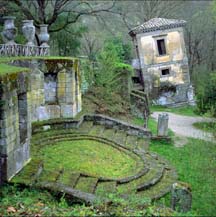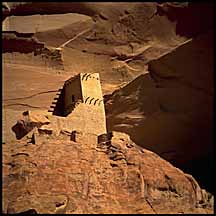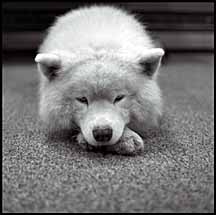Formalizing Photographic Aesthetics
by Philip Greenspun
Site Home : Research : One Article
 These are some research ideas that I'd like to pursue but don't
(because I keep working on integrating relational databases and the
Web).
These are some research ideas that I'd like to pursue but don't
(because I keep working on integrating relational databases and the
Web).
Better controls for photographers
What are the appropriate controls for a camera? Traditional cameras
have controls that are artifacts of the physical process of
silver-halide photography, e.g., aperture and shutter speed.
Computerized cameras with their "portrait" and "action" modes pull
away from these direct physical controls in a crude manner. In an age
of digital imaging, it is worth asking if cameras could be built with
direct aesthetic controls, e.g., a "romantic/clinical" knob or an
"Ansel Adams/Gary Winogrand" slider.
Before heading out to take pictures, a serious photographer makes
choices that have profound aesthetic consequences given the
limitations of silver-halide processes. For example, if a 1950s style
is desired, Kodak Tri-X black & white film will be selected for its
distinctive grain and look. Even if shot under ideal conditions in a
well-lit studio, the resulting images can never be used where color is
needed or a grainless modern style is desired. Perhaps with
appropriate digital imaging technology, the photographer could capture
detailed information on fine-grain color film or with an all-digital
camera, then process the images to look as though they'd been shot on
Tri-X.
 For a photograph of a tall building that preserves the architectural
lines is required, a photographer is currently forced to use a view
camera, i.e., a camera where the lens and film are not fixed parallel
to each other. It may be possible to simulate some view camera
movements with digital processing and thereby enable the photograph to
be taken with a simple Nikon.
For a photograph of a tall building that preserves the architectural
lines is required, a photographer is currently forced to use a view
camera, i.e., a camera where the lens and film are not fixed parallel
to each other. It may be possible to simulate some view camera
movements with digital processing and thereby enable the photograph to
be taken with a simple Nikon.
Achieving a grainless look and high color saturation in a traditional
print requires using low-speed (e.g., ISO 25 or 100) film that may
require compromises in depth-of-field, freezing action, and lens
weight. If the final image is intended for distribution via the World
Wide Web and for presentation on a computer screen, it may be possible
to achieve indistinguishable results using ISO 400 or ISO 800 film via
digital processing. It would be nice to have a formal method for
answering a question of the form: What is the maximum speed film I
can get away with given my desired output size?
 Sheet-film photographers such as Ansel Adams affirmatively control the
contrast of each image by varying the development time. This is not
possible with roll film, e.g., 35mm, where the entire roll must be
developed at once. However, by using wide-latitude film and making
multiple exposures at different shutter speeds, it should be possible
via digital processing to assemble a final image of any desired
contrast with detail in the shadows and highlights limited only by the
output medium. If the film or imaging sensor has the property of
silver halide crystals that a threshold certain number of photons are
needed before any image will be registered, it may be desirable to
pre-flash the entire frame before trying to capture shadow detail.
The question here: How many exposures and of what kind do I need with
a static subject to completely capture the scene for all practical
aethestic purposes?
Sheet-film photographers such as Ansel Adams affirmatively control the
contrast of each image by varying the development time. This is not
possible with roll film, e.g., 35mm, where the entire roll must be
developed at once. However, by using wide-latitude film and making
multiple exposures at different shutter speeds, it should be possible
via digital processing to assemble a final image of any desired
contrast with detail in the shadows and highlights limited only by the
output medium. If the film or imaging sensor has the property of
silver halide crystals that a threshold certain number of photons are
needed before any image will be registered, it may be desirable to
pre-flash the entire frame before trying to capture shadow detail.
The question here: How many exposures and of what kind do I need with
a static subject to completely capture the scene for all practical
aethestic purposes?

Producing exhibitions
Why is it that a book like Manhole Covers (MIT Press) is
art and a collection of snapshots, each containing a manhole, is not?
If a principal reason that Manhole Covers is art is the consistency of
presentation, i.e., same cropping, same proportions, same toning, same
grain, then can we turn snapshots into art under computer control?
Can we help the would-be artist by giving a collection a photos a
series of "looks" and letting the artist choose the best one? (Note
that in a photo exhibition, you usually see only one kind of photo,
e.g., black and white prints of 16x20" in size, framed in silver
aluminum, or vertical Cibachromes, 20x24" in size, all from Fuji
Velvia originals.)
Photographs gratuitously inserted into text (in hopes that more people
will read this) are copyright Philip
Greenspun. You can find 3000 more in my photography and
travel pages.
philg@mit.edu
Reader's Comments
First, I am amazed at the things you have done in the last three years. I have talked about you to dozens of people but it was pre-ArsDigita. A lot of water under the bridge in three years!! Obviously, your web experience is impressive and the photography is fantastic.
I shoot a Mamiya M645 when I am not chasing my 2, 6 and 8 year old boys around with my wife and when we get a chance to travel. Carried that sucker across Australia/New Zealand and the Middle East.
Sorry for the aside, but the point of my comment was...you state "If the film or imaging sensor has the property of silver halide crystals that a threshold certain number of photons are needed before any image will be registered, it may be desirable to pre-flash the entire frame before trying to capture shadow detail. The question here: How many exposures and of what kind do I need with a static subject to completely capture the scene for all practical aethestic purposes?"
With the recent phenomenal advances in digital capture rate in digital cameras [Example: (http://www.dpreview.com/news/0101/01010803twonewjvcs.asp)], do you have the question answered yet? Do the 3.3 megapixel cameras offer a "clean" palate for which all encoded images start from scratch?
Note - good luck with your lawsuit, and thanks for the incredible amount of writing across the website and links that I am relieved to see has NO misspellings! What a relief to see a website that is clean, funny, and written well! Steve Daugherty
-- Steve Daugherty, May 9, 2001
Dear Philip,
I like your essay on formalizing photographic aesthetics.
Imagine locating many different photographs in a multidimensional space, whose dimensions need to be figured out (character of the color, depth of field, composition, and 3 to 6 others). This space needs to characterize, gracefully and reasonably, a great variety of different photographic styles that we may seek at one time or another to emulate.
The task of the automatic-aesthetic camera (AAC) is to sample that space so that a reasonable number of points (photographs) are available for post-shoot processing. One picture cannot capture all your want. So you need smart bracketing to replace what is now rather naive bracketing. Thus the AAC will provide a set of wildly different pictures as it systematically moves through the multidimensional space of possible photographic styles--all applied to the same scene.
Now this is similar to what you are trying to do now with nouns (names of different photographers), as each noun in effect describes levels of 4 to 10 variables. So you could characterize 20 photographers by where they are located on the fundamental aesthetic variables. But my proposed method of sampling a multivariate space will produce combinations of aesthetic variables that no one has come up with or turned into a style.
This all would displace the act of making a photographic style from camera controls to the computer editing. Other than editing, the key action in making good photograph then becomes a matter of just showing up, which it already is. But with the AAC multiples to edit afterwards, you get a lot more information out of just showing up.
As ever,
ET
-- Edward Tufte, October 2, 2001
IEEE Computer, August 2006, is a special issue on computational photography. What can you do with GIGApixels? Merge different focus, contrast, and viewpoints to get high dynamic range, near-3D viewing, and "X-ray vision"! Not an "Ansel Adams" control, but shows how computation can help.
-- Paul E. Black, December 3, 2007
Add a comment | Add a link
 For a photograph of a tall building that preserves the architectural
lines is required, a photographer is currently forced to use a view
camera, i.e., a camera where the lens and film are not fixed parallel
to each other. It may be possible to simulate some view camera
movements with digital processing and thereby enable the photograph to
be taken with a simple Nikon.
For a photograph of a tall building that preserves the architectural
lines is required, a photographer is currently forced to use a view
camera, i.e., a camera where the lens and film are not fixed parallel
to each other. It may be possible to simulate some view camera
movements with digital processing and thereby enable the photograph to
be taken with a simple Nikon.
 These are some research ideas that I'd like to pursue but don't
(because I keep working on integrating relational databases and the
Web).
These are some research ideas that I'd like to pursue but don't
(because I keep working on integrating relational databases and the
Web).

